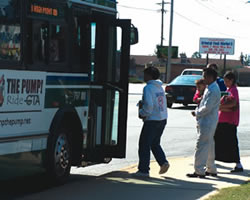 Transit agencies play an important role in improving the safety of pedestrians. Providing safe and comfortable routes to and from transit improves the passenger experience and helps transit agencies maximize ridership and customer satisfaction. This chapter presents policy and organizational approaches that transit agencies can use to help improve safety and access to transit for pedestrians.
Transit agencies play an important role in improving the safety of pedestrians. Providing safe and comfortable routes to and from transit improves the passenger experience and helps transit agencies maximize ridership and customer satisfaction. This chapter presents policy and organizational approaches that transit agencies can use to help improve safety and access to transit for pedestrians.
The chapter is divided into two sections. The first section, “Take Internal Action,” describes actions that transit agencies can typically implement independently to improve pedestrian safety and access. The second section, “Develop Partnerships,” describes actions that typically require transit agencies to work in partnership with other organizations to improve pedestrian conditions for their customers. Case study examples are provided throughout the chapter to illustrate how agencies across the United States have successfully undertaken similar initiatives.
All transit customers are pedestrians for some part of their journey to the bus or train. Therefore, there should be safe pedestrian conditions in the areas surrounding transit access points.
A. Take Internal Action
Most transit agencies have the authority to independently implement a number of pedestrian safety initiatives. These actions include making organizational improvements and modifying services and facilities. Even with limited resources, transit agencies can take a number of actions to improve pedestrian safety and access. Other actions may require a commitment of resources that pose a challenge to some transit agencies.
1. Make Organizational Improvements
Transit agencies can make organizational changes that can have long-term positive effects on pedestrian safety and convenience. These actions include reviewing and updating internal policies and procedures, such as:
- Establishing a pedestrian and/or bus stop coordinator position within the agency to work with local and state transportation departments, and citizens, and to review transit agency policies and operations. This coordinator should be in regular contact with transit agency staff working on route planning, scheduling, transit stop facilities, and coordination with other organizations. For example, the LYNX Customer Amenities Manual (Orlando, Florida) includes an internal phone list with contact names for specific pedestrian related issues.8
- Ensuring that the pedestrian/bus stop coordinator or other staff person is aware of construction activities planned at or around bus stops and other transit facilities and works with roadway agencies and their contractors to assure that adequate pedestrian access routes are provided during construction periods.
- Ensuring that all levels of agency management consider pedestrian safety issues in their day-to-day responsibilities.
- Providing periodic training on pedestrian safety to agency staff, consultants, and operators to improve the quality of transit service and the safety record of bus and train operators (see example). Staff and operators should follow a consistent set of safety guidelines and be clear about individual roles and responsibilities related to pedestrian issues. Potential topics for transit operator pedestrian safety training are listed on the next page. Examples of operator training programs include the Project for Public Spaces training modules for New Jersey Transit staff9 and a Washington Area Metropolitan Transit Authority (WMATA)10 bus driver training program that focuses on pedestrian safety, including safety statistics, crash causes, and applicable laws and tips for sharing the road with bicyclists and pedestrians.11
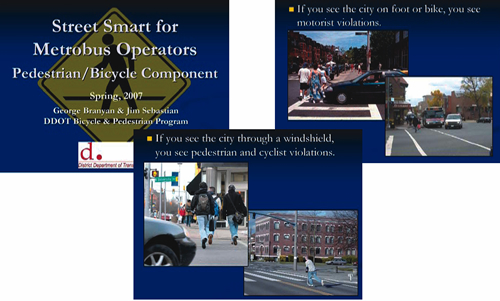
Pedestrian Safety Training for Transit Operators
The safety of passengers is a top priority for transit operators. Maintaining the safety of all pedestrians along transit routes is also important. Transit agencies should ensure that transit operators have received adequate safety training that acknowledges a variety of challenges, including:
- Operating in complex urban and suburban environments.
- Maintaining the safety of passengers inside the transit vehicle and the safety of people and vehicles in surrounding areas.
- Collecting patron fares.
- Responding to patron inquiries.
- Monitoring and addressing security concerns.
- Monitoring maintenance issues.
- Dealing with disruptive passengers.
- Adhering to schedules.
The length, frequency, and content of operator training programs should be sufficient to provide in-depth information about pedestrian issues. Training program guidelines and resources are provided by:
- The Federal Transit Administration (http://www.fta.dot.gov).
- The American Public Transportation Association (http://www.apta.com).
- The Community Transportation Association of America (http://www.ctaa.org).
2. Update Policies
Transit agencies can also improve pedestrian safety by updating internal policies. Policy actions that can be taken include:
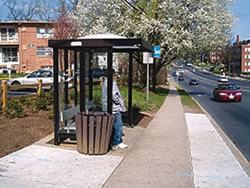 Compile and maintain a detailed inventory of bus stops and their features so that pedestrian safety and access improvement needs can be identified and prioritized.
Compile and maintain a detailed inventory of bus stops and their features so that pedestrian safety and access improvement needs can be identified and prioritized.- Incorporate pedestrian features into standard plans and standard designs for transit stops, stations and other transit facilities. Ensure that these features are included in cost estimates and programming details from project conception through construction and maintenance.
- Conduct pedestrian safety audits at transit stops and surrounding areas on a regular basis (examples are provided in Chapter 1).
- Develop or update transit-oriented development guidelines to ensure adequate pedestrian facility design, including sidewalks, pedestrian crossing facilities, and warning and wayfinding signs. Frequently, transit agencies will need to partner with local governments who are responsible for administering land development guidelines and regulations.
3. Modify Services and Facilities
Transit agencies typically have the authority to modify their services and facilities. These types of changes have the potential to improve pedestrian safety and access.
Service improvements may include:
- Changing bus routes and stop locations to reduce walking distances or facilitate transfers.
- Improving coordination between bus and rail schedules to allow for easier transfers and shorter waiting time.
Facility modifications may include:
- Moving bus stops to shorten walking distances, reduce street crossings or improve safety at street crossings for pedestrians accessing transit at each stop.
- Improving signage, seating, shelter, or lighting at bus stops.
- Increasing maintenance (frequency and thoroughness).
4. Identify Additional Resources
Limited resources are a common challenge for many transit agencies; transit providers frequently struggle to provide service and maintain their vehicles. Some of the internal actions suggested above require significant resources, so they can be difficult to enact. While there is no dedicated funding source for pedestrian safety improvements near transit stops at the federal level, there are many funding sources that can be leveraged by an agency in order to achieve these goals.
Some potential resources include:
- Consider allocating some capital improvement resources as matching funds to improve pedestrian safety and access in partnership with cities, counties, tribal governments, state departments of transportation (DOTs), regional agencies or other organizations.
- Implement a Tax Increment Financing (TIF) program to generate funding for physical improvements. For example, the MPO in Detroit, Michigan uses a TIF program for improvements to street lighting, sidewalks and curbs.12
- Surface Transportation Program (STP) funds, which are often adminis tered through the state DOT, can be used to improve and construct pedestrian walkways and bicycle facilities.13 Ten percent of each state’s STP allocation is set aside for “transportation enhancements”, which include pedestrian and bicycle facilities.14
- Bus and Bus Facility Grants (Section 5309) provided by the Federal Transit Administration (FTA) provide capital funding for transit-related improvements, including passenger shelters.15
- The Congestion Mitigation and Air Quality (CMAQ) Improvement Program, jointly administered by the Federal Highway Administration (FHWA) and the FTA, provides financial and technical resources for transit agencies and metropolitan planning organizations (MPOs) seeking to improve air emissions from transportation-related sources. Often these resources are applied to programs or projects that may also have a safety benefit. For example, the Transit Authority of River City (TARC) in Louisville, Kentucky is using CMAQ funds to acquire new buses that will provide safer rider access and egress and increased system reliability.16
B. Develop Partnerships
While transit agencies can make improvements for pedestrian access at the transit stop or station, they often need to work in partnership with other organizations to make pedestrian improvements in surrounding areas. Transit agencies can seek partnerships with the following groups:
- Local, regional and state agencies.
- Citizens and community groups.
- Developers.
- Other transit agencies.
Working with roadway owners to determine route locations, stop locations and passenger access facilities can yield the solution most appropriate for accommodating all modes of travel.
1. Local, Regional and State Agencies
It is important for transit agencies to coordinate with planning, highway, public safety, and public works departments on pedestrian issues. This coordination is important regardless of the transit agency’s organizational structure (e.g., separate authority or commission; department within a city, county, regional, or state government; subdivision of a larger department; or separate public or private corporation). Issues related to pedestrian safety near transit, such as sidewalk and pathway design, street crossings, and pedestrian separation from vehicular traffic— are typically the responsibility of other local and state agencies.
Transit operations occur on roads that are maintained and operated by various entities, and often cross through multiple jurisdictions. Typical roadway owners/operators may be state or county agencies, cities, towns or even private organizations (such as toll road operators, retail shopping centers, or homeowners associations). Transit service may have a significant impact on the number of pedestrians walking along the roadway as well as the vehicle capacity of the roadway. Conversely, pedestrian volumes and roadway operations can directly influence the ability of the transit agency to maintain reliable schedules. Working with roadway owners to determine route locations, stop locations and passenger access facilities can yield the solution most appropriate for accommodating all modes of travel.
Case Study: Mariner Park-and-Ride Pedestrian Safety Improvements
Community Transit, Snohomish County, Washington
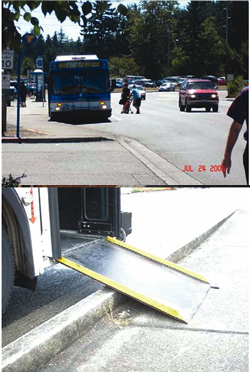 It is often assumed that pedestrian safety is not an important consideration at Park-and-Ride facilities because transit users are typically arriving by car. However, proper facility design and management is important to ensuring the safety of pedestrians walking to the Park-and-Ride.
It is often assumed that pedestrian safety is not an important consideration at Park-and-Ride facilities because transit users are typically arriving by car. However, proper facility design and management is important to ensuring the safety of pedestrians walking to the Park-and-Ride.
Several serious pedestrian and bicycle collisions occurred in the area of the Mariner Park-and-Ride facility in 2006 and 2007. There were no pedestrian shelters, a limited loading area, and difficult roadway crossings. To improve pedestrian safety and mobility in and around the Park-and-Ride facility, a partnership between Community Transit, Snohomish County, Washington, and Washington State DOT (WSDOT) was formed. The project received $700,000 in funding through WSDOT’s Pedestrian and Bicycle Safety Grant Program.17
The project is scheduled for completion in 2009. It includes adding pedestrian signals, constructing curbs and ADA accessible ramps, realigning skewed Park-and-Ride entrances to provide more direct pedestrian crossings and slow turning vehicles, and adding new pedestrian lighting and signage. The project also has an education and encouragement component that will expand Community Transit’s ongoing efforts to promote pedestrian and bicycle safety. This includes a targeted pedestrian and bicycle safety media campaign using rider alerts, website information, newspaper outreach and other information outlets. Finally, the enforcement component of this project will provide funding to local law enforcement agencies to increase pedestrian and bicycle safety patrols at the Park-and-Ride facility and surrounding areas.
Contact: Paula Reeves, Community Design Assistance Branch Manager, (360) 705-7258, ReevesP@wsdot.wa.gov.
It is important to coordinate activities between the transit agency and the agency responsible for the roadway. Through regular dialogue, the local public works department or department of transportation may be able to incorporate specific improvements into their projects that could benefit pedestrian safety for transit customers including:
- Construction or enhancement of sidewalks near transit.
- Relocation and design of bus stops that promotes safer pedestrian access and egress.
- Appropriate roadway design speeds in areas where pedestrians access transit.
- Intersection signalization that facilitates safer pedestrian crossings.
- Regular maintenance of pedestrian facilities.
- Incorporation of transit access improvements into land development or redevelopment projects.
Coordination between transit agencies and local agencies can also ensure that adequate provisions are made for safe pedestrian access to transit during periods of roadway construction.
Actions that transit agencies can take to foster partnerships with local, regional and state transportation agencies to improve pedestrian safety and access include:
- Develop quick reference contact list of key departments, agencies and staff with responsibilities related to pedestrian safety. In particular, transit agencies should communicate regularly with local, regional and state pedestrian and bicycle coordinators.
- Develop intergovernmental agreements and memoranda of understand ing on pedestrian facilities in areas surrounding transit access points.
- Arrange regular meetings to discuss pedestrian safety and access issues.
- Develop bus stop placement agreements for private roads.
- Engage in project review and scoping processes with local and state planning departments. Make every effort to be included from the earliest stages of the planning process.
- Host workshops to discuss pedestrian safety issues with local jurisdic tions and organizations.
- Establish joint pedestrian and bicycle task forces and committees with lo cal jurisdictions and organizations.
Example: Virginia Department of Transportation
The Virginia Department of Transportation (VDOT) has a pedestrian coordinator who reviews all development projects to ensure the accessibility of pedestrian and bicycle facilities. VDOT conducts periodic workshop programs on pedestrian safe design for local government officials, contractors and consultants. By coordinating with VDOT staff, a local transit agency can establish an advocate in the development process who will encourage designers to account for pedestrian safety near transit.18
Case Study: Interagency Partnerships
Tri-Met, Portland, Oregon19
Tri-Met, the transit agency serving the Portland metropolitan area, has developed a coordinated plan for bus stop management that recommends developing intergovernmental agreements and memoranda of understanding with city, state and county departments and agencies. Tri-Met and the City of Portland now have such an agreement in place that aids in the siting and permitting of bus shelters and other transit facilities. Tri-Met also works with local jurisdictions to review major development plans and request improvements at or near bus stops. Furthermore, if the agency determines that sufficient ridership potential exists at a new site, they can request that the developer provide and maintain bus stop facilities.
The transit agency also developed an agreement with the City’s Project Planning Department and the Bureau of Maintenance. Success lies in clearly defining the role and responsibility of each person and agency. Tri-Met’s detailed recommendations regarding interdepartmental coordination can be found in the agency’s Bus Stop Guidelines 2002. The document outlines responsibilities related to bus stops for each department and position, such as:
- Project Planning Department’s Capital Projects Management Section (responsible for design and placement of bus stop amenities):
- Programs Manager.
- Project Planner.
- Maintenance Supervisor.
- Adopt-a-Stop Program Coordinator.
- Planner/Analyst.
- Community Relations Specialist.
- Additional departments for Bus Stop Section to coordinate with:
- Service Planning Department and Scheduling Department.
- Field Operations Supervisors.
- Maintenance Technicians.
- Information Development Department.
- Marketing Department.
- Committee on Accessible Transportation.
- Public Art Program.
- Safety, Training and Real Property.
Contact: Young Park, (503) 962-2138, parky@trimet.org.
2. Residents and Community Groups
Transit agencies can take advantage of relationships with citizens and community groups to improve pedestrian safety for their customers. Several strategies for enhancing these relationships are described in this section:
- Work with residents to identify pedestrian access issues that need im provement.
- Educate residents about pedestrian and transit safety issues.
- Work with community members to develop solutions to improve pedes trian safety.
Work with Residents to Identify Pedestrian Issues
Positive relationships with community members enhance the public image of a transit agency. This can also help increase transit ridership and lead to increased funding.
Transit agencies can take advantage of partnerships with community groups to gather important information about pedestrian access issues and needs. Agencies can assess existing conditions for pedestrian safety near transit stops and stations by doing the following:
- Encourage the creation of community task forces for new construction and redevelopment projects.
- Encourage community participation in project advisory committees.
- Encourage resident participation in community safety teams.
- Enlist community help with transit accessibility audits.
- Develop “Adopt-A-Stop” programs with riders and businesses.
- Encourage residents to report safety issues.
- Develop quick reference phone lists for residents to contact the appropriate person in your transit agency.
- Develop easy-to-use websites with information directed at community groups.
Positive relationships with community members enhance the public image of a transit agency.
Case Study: Community Pedestrian Safety Committee
Brookline, Massachusetts20
In October 1987, an elderly pedestrian was killed by an automobile while she was trying to access the Beacon Streetcar line in Brookline, Massachusetts. Immediately following the incident, community advocates worked with town officials to install a pedestrian signal at the site of the crash. However, many of the 12 other heavily-used surface stops in the corridor still had no pedestrian signals. By 1994, another seven people had been killed trying to access these surface stops. When activists again demanded action, they learned that Beacon Street was being redesigned by the state highway department. The highway department agreed to fund 90% of the replacement cost for the street’s old traffic lights contingent upon the town addressing the high pedestrian and automobile accident rate. The town created a 20 person committee comprised of residents, members of the Planning Board, Conservation Commission, Chamber of Commerce and the Transportation Board, a pedestrian safety advocate, and a planner from the Massachusetts Bay Transit Authority (MBTA). The committee met bi-weekly to make recommendations on design aspects of the project. Key design features for safe access to the streetcar included:
- Street narrowing to two lanes in each direction plus parking lanes.
- Pedestrian signals.
- Increased tree plantings and landscaping.
- Increased separation between passenger boarding areas and moving traffic.
- Curb extensions at many street corners.
- Tighter curb radii.
- Bulb-outs at stations to provide safe waiting areas for streetcar passengers.
By the end of the design process, the committee was able to get almost all recommendations implemented, balancing the needs of pedestrians, transit users, and vehicles.
Many of the improvements recommended by the committee were installed at stations in 2007. The pedestrian signals (many equipped with a countdown) and signal preemption system have improved pedestrian safety and transit operations. However, obstructed sightlines and inconsistent signalization can still make crossing the street to access the streetcar line challenging.
Contact: Dorthea Haas, WalkBoston, (617) 232-0104, dhaas@walkboston.org.
Case Study: Pilot Bus Stop Audit Program21
Boston, Massachusetts
WalkBoston, a non-profit organization dedicated to improving walking conditions in cities and towns across Massachusetts, launched a demonstration program, the Neighborhood Bus Stop Program, in Roxbury/Dorchester, Massachusetts in 1998. The program was designed to improve access to transit, walking conditions, lighting, street crossings, signage, bus stop amenities and landscaping with the ultimate goal of increasing bus ridership.
The Neighborhood Bus Stop Program included a comprehensive audit of bus stops in Roxbury/Dorchester and recommendations for improvements that would enhance pedestrian safety and increase ridership. WalkBoston presented results of the audit and potential improvement strategies to the transit agency to demonstrate program feasibility and cost effectiveness. Key lessons learned from this effort include:
- Start with a demonstration project, not the whole system.
- Reach out to citizens and major employers whose customers and employees use transit for advocacy, funding and auditing support.
- Encourage advertising on transit shelters to generate revenue.
- Meet with the neighborhood groups and recruit assistance.
- Be positive and continue coordination between governments, transit agencies and neighborhoods.
Based in part on the efforts of WalkBoston, the project has grown into a system-wide program throughout the metropolitan Boston area. Over the past several years attractive glass shelters have been installed throughout the region, especially at stops in low-income and minority areas. Using an innovative public/private partnership, these bus stops are installed and maintained by a private firm that finances the effort through advertising sales.
Contact: Dorthea Haas, WalkBoston, (617) 232-0104, dhaas@walkboston.org.
Educate Community Members about Transit and Pedestrian Safety
There are a number of programs that transit agencies can initiate or participate in to provide pedestrian safety education to community members. These include:
- School safety programs for students walking to and riding public transit buses (classroom training can include videos, site specific photos, handouts etc.).
- Local police enforcement of pedestrian-related traffic laws.
- Local police enforcement at highway/rail crossing gates.
- Pedestrian safety training theaters with videos for schools, businesses, churches, community events, etc.
- Distribution of safety materials to group events.
Successful educational outreach programs increase pedestrian safety for existing riders, and can also serve as orientation programs for new riders.
Work with Community Members to Solve Pedestrian Issues
Leveraging community resources has proven to be an inexpensive and effective method for improving conditions for pedestrians accessing transit. Transit agencies can involve community members and groups in developing policies for improving the design and siting of transit stops. These activities allow residents to have input into how transit is integrated into the community as a whole.
Volunteer bus stop maintenance programs are another way to involve the community in improving transit. These programs can be established between transit agencies and businesses, commercial centers, volunteer agencies, youth programs and even citizens in exchange for various incentives. Programs can increase community involvement in transit and encourage citizens to take ownership of their local bus stops. In addition, they can reduce agency maintenance costs and improve safety by alerting transit agencies of special maintenance needs, vandalism or suspicious activities. Many transit agencies have developed these types of programs including:
- Tri-Met’s Adopt-A-Stop22 and Keep-A-Can23 programs in Portland, Oregon: 800 adopted stops and 80% reduction in litter in exchange for 10 free bus rides each month.
- MTA’s Adopt-A-Shelter Program in Flint, Michigan.24
- King County Metro’s Adopt-A-Stop Program in Seattle, Washington.25
Transit agencies can also involve community residents and organizations in pedestrian safety by inviting them to participate in safety workshops. These meetings allow citizens to highlight problem locations for pedestrians, brainstorm ideas for improving rider safety, and have open discussions with agency staff about pedestrian safety policies.
Case Study: Regional Pedestrian & Bike Safety Workshop26
Washington Metropolitan Area Transit Authority, Washington DC
In 2006 and 2007, the Washington Metropolitan Area Transit Authority (WMATA) hosted a series of regional workshops focusing on pedestrian and bicycle safety issues related to transit access.
| Amenity | Customer Boarding Activity per Day |  |
|||||
|---|---|---|---|---|---|---|---|
| < 50 | 50- 100 |
100- 300 |
300- 500 |
Over 100 |
|||
| Concerte pad | [X] | [X] | [X] | [X] | [X] | ||
| Safe access | [X] | [X] | [X] | [X] | [X] | ||
| Adequate lighting | [X] | [X] | [X] | [X] | [X] | ||
| Accurate bus stop signs | [X] | [X] | [X] | [X] | [X] | ||
| Accurate bus stop signs | [X] | [X] | [X] | [X] | [X] | ||
| Standard shelter | [X] | [X] | [X] | [X] | |||
| Trash receptacle | [X] | [X] | [X] | [X] | |||
| Detailed schedule | [X] | [X] | [X] | ||||
| Larger/Multiple shelter(s) | [X] | [X] | [X] | ||||
| Benches in shelter | [X] | [X] | [X] | ||||
| System map | [X] | [X] | |||||
| Real time travel info | [X] | [X] | |||||
| Potential conversion to transit center | [X] | ||||||
| WMATA staff presented an example of bus stop facility standards based on boardings per day. Source: DDOT and WMATA. | WMATA staff discussed new bus route maps provided at rail stations to encourage riders to use local buses. | ||||||
The workshops brought together a wide range of stakeholders to discuss important pedestrian and bicycle safety concerns. Participants in the workshops included WMATA and other transit agency staff, pedestrian and bicycle advocates, engineers and public works staff from several Washington area jurisdictions, as well as members of and advocates representing the interests of people with disabilities in the community. Elected officials and decision-makers at the highest level of WMATA took part in the events. Committees were established to develop recommendations and priorities for improving pedestrian and bicycle access to transit. The overarching goals of the plan included safety, sustainability, and partnerships.
These workshops represented one of the first times that officials for WMATA, the Metro Washington Council of Governments (MWCOG), and from almost all of the local jurisdictions in the DC region worked collaboratively to address issues of transit accessibility and safety. In the spring of 2008, WMATA and MWCOG will undertake a joint project to identify and address obstacles to transit access for disabled users of the regional transit system. Additionally, WMATA and local governments are providing safety training for transit operators in a series of workshops held throughout the region.
Contact: Kristen Haldeman, WMATA Office of Business Planning & Project Development, (202) 962-1848.
3. Land Developers
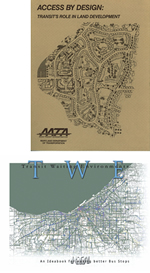 Transit agencies should provide developers with development guidelines and standards prior to any project’s design phase to ensure that the development is transit-oriented. A good working relationship between the transit agency and the planning and zoning department and/or planning and design standards committee is critical as well. Transit agencies can provide developers with the following tools:
Transit agencies should provide developers with development guidelines and standards prior to any project’s design phase to ensure that the development is transit-oriented. A good working relationship between the transit agency and the planning and zoning department and/or planning and design standards committee is critical as well. Transit agencies can provide developers with the following tools:
- The transit agency’s guidelines and standards. Several agencies provide guidelines for developers. For example, the Tri-County Metropolitan Transportation District of Oregon in Portland produced the Planning and Design for Transit Handbook.27
- Transit oriented development (TOD) guidelines. For example, the Suburban Mobility Authority for Regional Transportation (SMART) Guide for Creating a Friendly Transit Environment28 provides TOD guidance for businesses, government agencies, citizens, and design professionals in suburban Detroit; the San Diego MetropolitanTransit Development Board’s Designing for Transit29 guide suggests 10 ways to design more transit-oriented communities; and the Greater Cleveland Regional Transit Authority (GCRTA) provides guidance for local municipalities to create mixed- use developments and moderate to high densities near transit stops in the Cleveland region.30
- Transit accessibility checklists. SMART’s Guide for Creating a Friendly Transit Environment and the Maryland Transit Administration’s Access by Design31 guides include accessibility checklists for developers.
- Technical assistance estimating impact fee or developer fee reductions due to the inclusion of transit- and pedestrian-oriented design features.
Case Study: Agreements for Bus Stop Placement32
Pierce Transit, Takoma, Washington
The jurisdictions in the Takoma, Washington region have given Pierce Transit the opportunity to review most major new development and redevelopment projects within its service area.33 Each jurisdiction served by the transit agency has established guidelines whereby the developer may be required to provide transit enhancements when specific criteria are met. Additionally, the agency can recommend infrastructure changes such as sidewalks, through-streets, or other enhancements for improving pedestrian safety and access to transit when a site is developed.
Pierce Transit has also developed a standard agreement that gives the agency the ability to locate bus stops on private roads.34 Pierce Transit signs this agreement with the owners of private property on which they would like to locate a stop. These agreements allow the agency to locate the bus stop in the most accessible location for pedestrians.
Contact: Linda Shaffer, Planner Construction Projects, (253) 983-2714, lshaffer@piercetransit.org.
